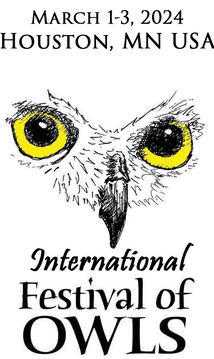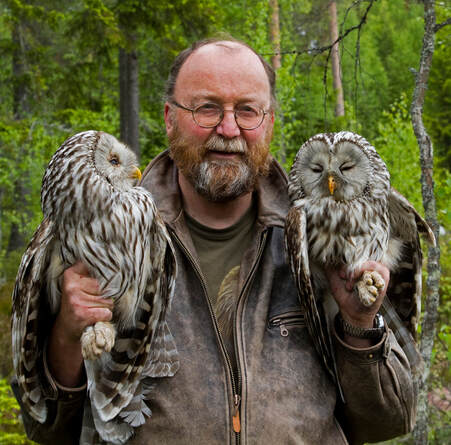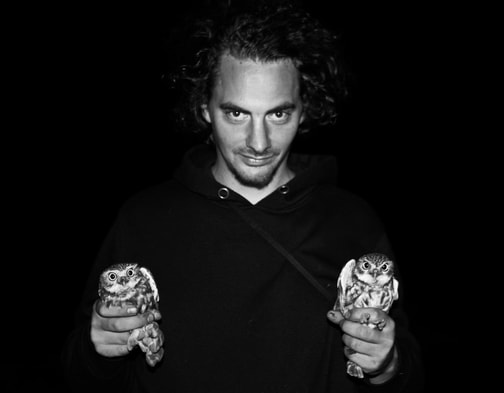Champion of Owls Award
Dr. Roar Solheim, Norway
If you want a feather-perfect owl mount, Dr. Roar Solheim is your man. In addition to doing traveling owl taxidermy exhibitions, Roar works as the Senior Curator of Zoology at the Natural History Museum and Botanical Garden, part of the University of Agder in Kristiansand, Norway. His mounted owls usually illustrate natural behaviors of the species, and he can revive even the most badly damaged of specimens.
Roar doesn’t just hang around with dead birds; he has 43 years of experience with living ones, too! He conducts research on Great Gray, Snowy, Eurasian Eagle, Eurasian Pygmy, Boreal, Ural and Tawny Owls including nest box studies, telemetry work, and deciphering molting patterns to determine age. He pioneered the concept of identifying individual owls using unique wing markings. This technique is very helpful when trying to determine if the same bird is staying in or returning to an area without needing to capture it and can be done by any member of the public with a good zoom lens. Especially impressive is his work using satellite telemetry with Great Gray Owls, the first time it has been done with this species.
You don’t win a Champion of Owls award by keeping your findings to yourself, though. This “Crazy Norwegian Guy” is a founding and active member of the International Snowy Owl Working Group, which shares Snowy Owl research techniques and information with Snowy Owl researchers around the world. Roar has written more than 700 articles about owls, zoology and nature (at least 85 were peer-reviewed papers about owls in Norwegian, Swedish, English, and Dutch); created 115 radio programs for Norwegian Broadcasting; and given 330 lectures on a wide range of topics. He has presented his owl research at conferences in Norway, Sweden, Denmark, The Netherlands, Portugal, and the United States. His presentations, both public and scientific, are always lively, engaging, and sure to include his amazing repertoire of owl and other animal sounds.
Dr. Roar Solheim, Norway
If you want a feather-perfect owl mount, Dr. Roar Solheim is your man. In addition to doing traveling owl taxidermy exhibitions, Roar works as the Senior Curator of Zoology at the Natural History Museum and Botanical Garden, part of the University of Agder in Kristiansand, Norway. His mounted owls usually illustrate natural behaviors of the species, and he can revive even the most badly damaged of specimens.
Roar doesn’t just hang around with dead birds; he has 43 years of experience with living ones, too! He conducts research on Great Gray, Snowy, Eurasian Eagle, Eurasian Pygmy, Boreal, Ural and Tawny Owls including nest box studies, telemetry work, and deciphering molting patterns to determine age. He pioneered the concept of identifying individual owls using unique wing markings. This technique is very helpful when trying to determine if the same bird is staying in or returning to an area without needing to capture it and can be done by any member of the public with a good zoom lens. Especially impressive is his work using satellite telemetry with Great Gray Owls, the first time it has been done with this species.
You don’t win a Champion of Owls award by keeping your findings to yourself, though. This “Crazy Norwegian Guy” is a founding and active member of the International Snowy Owl Working Group, which shares Snowy Owl research techniques and information with Snowy Owl researchers around the world. Roar has written more than 700 articles about owls, zoology and nature (at least 85 were peer-reviewed papers about owls in Norwegian, Swedish, English, and Dutch); created 115 radio programs for Norwegian Broadcasting; and given 330 lectures on a wide range of topics. He has presented his owl research at conferences in Norway, Sweden, Denmark, The Netherlands, Portugal, and the United States. His presentations, both public and scientific, are always lively, engaging, and sure to include his amazing repertoire of owl and other animal sounds.
Special Achievement Award
Martin Šálek, Czechia
Little Owls have undergone a precipitous crash in Czechia, dropping from a population of thousands to just 100 to 130 breeding pairs. Dr. Martin Šálek has spent the last 25 years working in every way possible to reverse this trend.
Martin got hooked in high school, helping with Little Owl monitoring. He now coordinates the national Little Owl survey and authored the National Little Owl Action Plan. He has published 22 scientific papers on many aspects of the owls, including demographics, mortality, movement, vocalization, habitat selection and genetics. He has overseen many graduate and PhD students, maintains about 140 nest boxes, and started a pilot food supplementation program to increase survival of the young. He collaborates with researchers elsewhere in Europe and has presented his research at owl conferences in Portugal and India.
Because Little Owl conservation is based so heavily on farm habitat, Martin also works with farmers and the public. He has been featured in all the major media in Czechia, from TV to radio to newspapers. He’s also created posters for children, been featured in a documentary, and maintains social media and a website to educate the public. He places importance on his conversations with individual farmers to help them promote better land management and reduce threats to the owls posed by poisons, water troughs, and chimneys.
Expect Martin’s passion for Little Owl conservation to keep him in the news and in the field, doing everything possible to save this charismatic and charming friend of farmers.
Franta, Martin's dedicated owl catching "helper", has undergone various iterations over the years (pictured below).
Martin Šálek, Czechia
Little Owls have undergone a precipitous crash in Czechia, dropping from a population of thousands to just 100 to 130 breeding pairs. Dr. Martin Šálek has spent the last 25 years working in every way possible to reverse this trend.
Martin got hooked in high school, helping with Little Owl monitoring. He now coordinates the national Little Owl survey and authored the National Little Owl Action Plan. He has published 22 scientific papers on many aspects of the owls, including demographics, mortality, movement, vocalization, habitat selection and genetics. He has overseen many graduate and PhD students, maintains about 140 nest boxes, and started a pilot food supplementation program to increase survival of the young. He collaborates with researchers elsewhere in Europe and has presented his research at owl conferences in Portugal and India.
Because Little Owl conservation is based so heavily on farm habitat, Martin also works with farmers and the public. He has been featured in all the major media in Czechia, from TV to radio to newspapers. He’s also created posters for children, been featured in a documentary, and maintains social media and a website to educate the public. He places importance on his conversations with individual farmers to help them promote better land management and reduce threats to the owls posed by poisons, water troughs, and chimneys.
Expect Martin’s passion for Little Owl conservation to keep him in the news and in the field, doing everything possible to save this charismatic and charming friend of farmers.
Franta, Martin's dedicated owl catching "helper", has undergone various iterations over the years (pictured below).
|
The International Festival of Owls is a fundraiser for the International Owl Center and the Center’s biggest event of the year.
|





